Laminate Countertops
Choosing the ideal countertops for your kitchen remodel can be a difficult undertaking. It might be challenging to determine which material best suits your lifestyle and price range when there are so many options available. Laminate countertops are a choice that has been popular for many years. We’ll cover everything you need to know about in this article, including their benefits and drawbacks, how to care for them, what design and style options are available, how to install them, and how they stack up against other countertop materials.
What is a Laminate Countertop?
A synthetic material known as laminate is created by pressing together numerous layers of paper or cloth that have been saturated with resin. A decorative paper with a printed pattern or design makes up the top layer of laminate, giving it its distinctive appearance. In order to create laminate countertops, a laminate sheet is first glued to a core composed of particleboard or MDF (medium-density fiberboard), which is then cut and edged to suit the countertop base.

Based on the edge style, laminate countertops come in three different varieties: square, beveled, and bullnose. The most typical edge is square, which has a flat, sharp edge. Both the top and bottom sides of a beveled edge are slightly angled. Bullnose edges have rounded, smooth edges that are safer for kids and simpler to clean.
Advantages of Laminate Countertops
Affordability: Laminate countertops are one of the most budget-friendly options on the market, costing less than half the price of natural stone or quartz countertops.
Wide variety of styles and colors: Laminate countertops come in a vast array of colors, patterns, and textures, from solid colors to faux granite, marble, or woodgrain.
Durability: Laminate countertops provide a great level of resistance to stains, impacts, and scratches. Also, they are water-resistant, making them appropriate for places with a lot of moisture like bathrooms and kitchens.
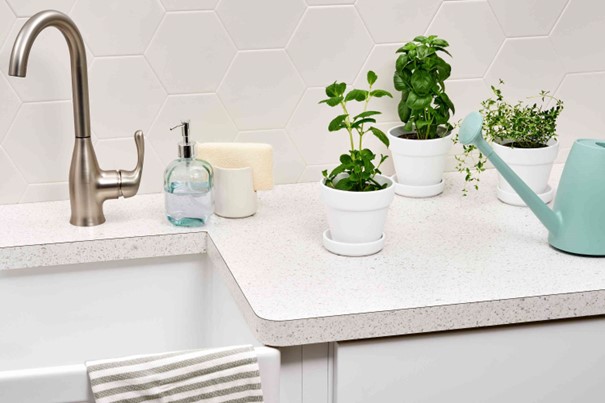
Easy maintenance: Low-maintenance laminate counters can be cleaned with soap and water or a gentle home cleaner. They don’t need to be sealed or resealed on a regular basis, unlike countertops made of natural stone or solid surface.
Resistance to stains and scratches: Laminate countertops have a hard surface that is difficult to scratch or stain. They are less susceptible to discoloration from acidic foods or beverages than natural stone or concrete countertops.
Disadvantages of Laminate Countertops
Laminate countertops are not heat-resistant and can be harmed by hot pans or dishes. They are also susceptible to moisture damage. If they are exposed to too much moisture, they are also susceptible to swelling or warping.
In contrast to solid surface or natural stone countertops, laminate countertops cannot be fixed if they get chipped, cracked, or scratched. The countertop must be replaced in its whole or just the damaged area.
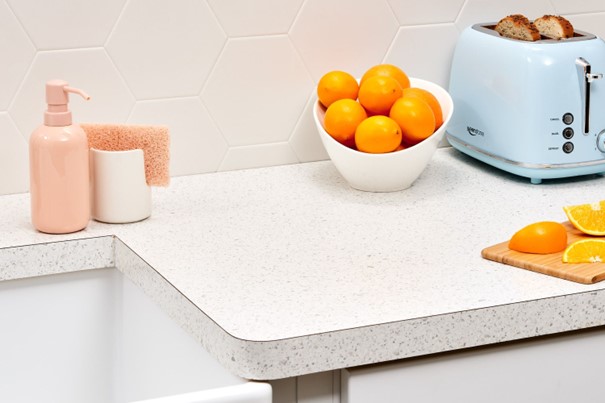
Laminate countertops may reduce the resale value of your property even though they are functional and inexpensive and are not seen as luxury features.
Not a good surface for cutting on: Sharp blades can quickly scratch or gouge laminate counters, which are not intended to be used as cutting boards.
Care and Maintenance of Laminate Countertops
To keep your laminate countertops looking their best, follow these care and maintenance tips:
- Clean spills and stains immediately with soap and water or a mild household cleaner.
- Avoid placing hot pots or dishes directly on the countertop. Use trivets or heat-resistant pads instead.
- Wipe up any standing water or moisture on the countertop to prevent swelling or warping.
- Use a cutting board to protect the countertop from scratches and gouges from sharp knives.
- Avoid using abrasive or acidic cleaners that can damage the surface of the countertop.
Design and Style Options for Laminate Countertops
Laminate countertops offer a wide range of design and style options to fit any kitchen décor. Some popular options include:
Solid colors: Laminate countertops in solid colors are a terrific option for a traditional and timeless appearance. They are available in a range of colors, including vibrant hues like red, blue, and green as well as neutral tones like white, beige, and gray.
Patterns and textures: Natural stones like granite, marble, or slate, as well as other materials like wood or metal, can all be imitated in laminate countertops. Even some laminate countertops have a textured surface that gives the countertop depth and volume.
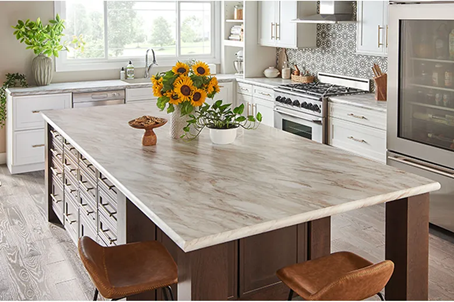
Edge treatments: The edges of laminate countertops can be polished in a variety of ways, from a straightforward square edge to a more aesthetically pleasing beveled or bullnose edge. For a softer appearance, some laminate countertops also include a rolled edge that curves over the top and bottom of the countertop.
Accessories and features: You can add backsplashes, drainboards, and built-in sinks to laminate countertops to make them more unique. They can also be combined with a beautiful tile or a laminate backsplash that matches.
Installation of Laminate Countertops
Installing a laminate countertop is a straightforward process that can be done by a DIYer or a professional installer. The steps involved in the installation process are:
Prepare the surface: The countertop base must be clean, level, and free of any bumps or irregularities. If necessary, use a sander to smooth out the surface.
Cut the countertop: Measure and cut the laminate sheet to fit the countertop base, leaving a 1-inch overhang on all sides.
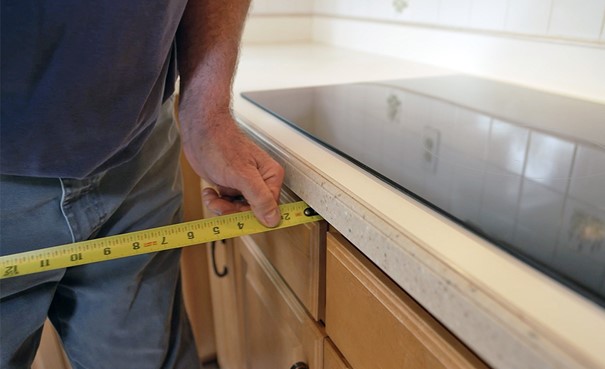
Glue the laminate sheet: Apply contact cement to both the countertop base and the back of the laminate sheet. Let the cement dry for 15-20 minutes, then carefully align and press the laminate sheet onto the base.
Trim the edges: Use a router or a laminate trimmer to trim the excess laminate from the edges of the countertop.
Finish the edges: Sand and file the edges of the countertop to smooth out any rough spots. Apply a laminate edge banding or a matching sealant to the edges for a finished look.
Comparison of Laminate Countertops with Other Countertop Materials
Laminate countertops have some advantages and disadvantages when compared to other countertop materials. Here is a brief comparison:
Granite and marble: Although natural stone countertops are pricey and need ongoing upkeep, they are heat-resistant, long-lasting, and increase the value of your property.
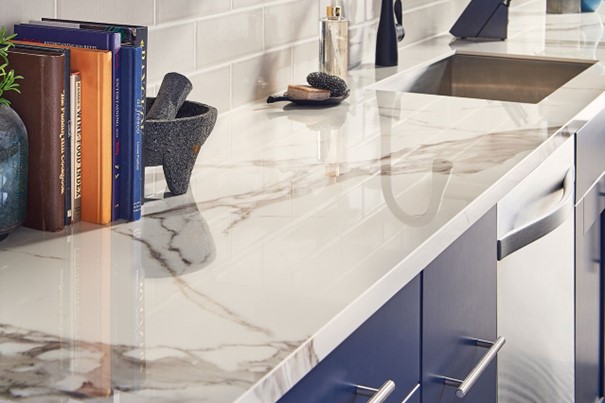
Quartz and engineered stone: These countertops are highly durable, stain-resistant, and require little maintenance, but they are costly and may not have the same natural look and feel as granite or marble.
Solid surface and acrylic: These countertops are affordable, durable, and can be repaired if damaged, but they may not be as heat-resistant as natural stone or quartz.
Tile and concrete: These countertops offer endless design possibilities and are highly customizable, but they may require more maintenance than other countertop materials.
Final Thought
For any kitchen remodel, laminate worktops are a cheap, useful, and fashionable alternative. They come in a broad variety of colors, patterns, and textures, require minimal care, and may be tailored to meet your design tastes. They do, however, have some restrictions, such as being unable to be repaired if destroyed and being vulnerable to heat and moisture damage. Overall, homeowners searching for a practical and affordable countertop alternative should consider laminate countertops.
As Granite Expo, don’t forget to contact us to find the most suitable one for you from our thousands of different kitchen remodeling projects.
